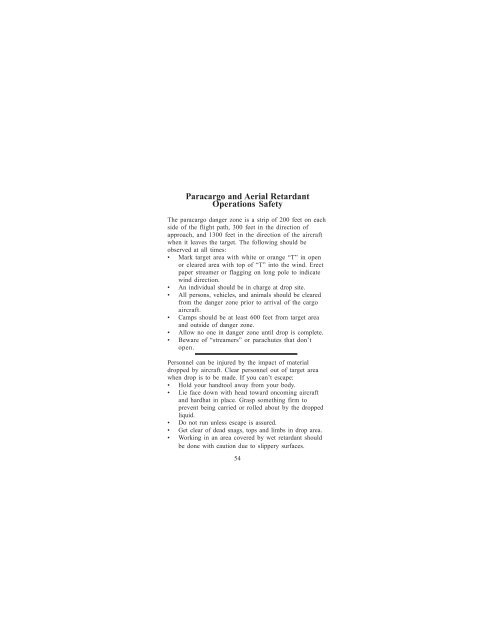Incident Response Pocket Guide - KUMEYAAY.info
Incident Response Pocket Guide - KUMEYAAY.info
Incident Response Pocket Guide - KUMEYAAY.info
Create successful ePaper yourself
Turn your PDF publications into a flip-book with our unique Google optimized e-Paper software.
Paracargo and Aerial Retardant<br />
Operations Safety<br />
The paracargo danger zone is a strip of 200 feet on each<br />
side of the flight path, 300 feet in the direction of<br />
approach, and 1300 feet in the direction of the aircraft<br />
when it leaves the target. The following should be<br />
observed at all times:<br />
• Mark target area with white or orange “T” in open<br />
or cleared area with top of “T” into the wind. Erect<br />
paper streamer or flagging on long pole to indicate<br />
wind direction.<br />
• An individual should be in charge at drop site.<br />
• All persons, vehicles, and animals should be cleared<br />
from the danger zone prior to arrival of the cargo<br />
aircraft.<br />
• Camps should be at least 600 feet from target area<br />
and outside of danger zone.<br />
• Allow no one in danger zone until drop is complete.<br />
• Beware of “streamers” or parachutes that don’t<br />
open.<br />
Personnel can be injured by the impact of material<br />
dropped by aircraft. Clear personnel out of target area<br />
when drop is to be made. If you can’t escape:<br />
• Hold your handtool away from your body.<br />
• Lie face down with head toward oncoming aircraft<br />
and hardhat in place. Grasp something firm to<br />
prevent being carried or rolled about by the dropped<br />
liquid.<br />
• Do not run unless escape is assured.<br />
• Get clear of dead snags, tops and limbs in drop area.<br />
• Working in an area covered by wet retardant should<br />
be done with caution due to slippery surfaces.<br />
54
















